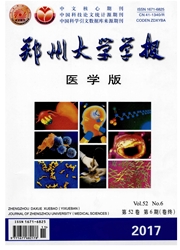

 中文摘要:
中文摘要:
目的:观察我国3个旋毛虫地理株肌幼虫的形态,并测定其生殖力,为旋毛虫属的分类提供依据。方法:对我国河南(Hn)、黑龙江(Hlj)及云南(Yn)的3个猪源旋毛虫地理株肌幼虫进行长度测量,并观察25℃与4℃下的形态。40只昆明小鼠随机分为8组,每组5只,分别感染8个不同种和地理株旋毛虫,每只小鼠经口感染100条肌幼虫,感染后40d剖杀,人工消化法消化全身肌肉后按贝氏分离法收集肌幼虫,进行不同种株的生殖力指数(RCI)测定,并与旋毛虫(T1)、乡土旋毛虫(T2)、布氏旋毛虫(T3)、伪旋毛虫(T4)及纳氏旋毛虫(T7)国际参考株进行比较。结果:3个地理株肌幼虫长度分别为(1.183±0.063)mm、(1.054±0.068)mm及(1.159±0.086)mm,与T1参考株长度((1.107±0.049)mm)相比,差异均有统计学意义(P均〈0.05)。T4肌幼虫最小((0.841±0.038)mm),与其他种(T1、T2、T3、T7)及3个地理株相比差异均有统计学意义(P均〈0.05)。T2肌幼虫在25℃下螺旋状卷曲数所占比例(24.34%)与其他种与地理株肌幼虫相比差异均有统计学意义(P均〈0.05),但其他种与地理株肌幼虫在25℃和4℃下形态变化无明显的规律性。不同种与地理株的RCI以河南株最高(297.500±12.179),其次分别为T1(279.670±6.408)、T4(186.670±5.391)、T7(158.080±11.630)、云南株(154.2504-16.535)、T3(86.330±2.944)及黑龙江株(68.670±3.266),T2的RCI最低(55.290±4.196);各组的RCI相比差异有统计学意义(P〈0.05)。结论:旋毛虫肌幼虫形态和RCI不能用于区分种和地理株的生物学特征,但可作为旋毛虫属分类的参考指标。
 英文摘要:
英文摘要:
Aim: To provide the evidence for the classification of Trichinella genus by observing the morphology and measuring the reproductive capacity of the Trichinella muscle larva in china. MethodS:The length, morphology of Trichinella muscle larvae at 25 ℃ and 4 ℃ , and their reproductive capacity index (RCI) were measured using the swine isolates from Henan (Hn) , Heilongjiang (Hlj) and Yunnan (Yn) provinces of China. The results were compared with those of the international reference isolates of T. spiralis (T1), T. native (T2), T. britovi (T3), T. pseudospiralis (T4) and T. nelsoni ( T7 ). Results: Lengths of the three isolates were ( 1.183 ± 0. 063 ) mm, ( 1. 054 ± 0. 068 )mm and ( 1.159 ± 0. 086 ) mm, respectively, showing significant difference with that of T1 muscle larvae (P 〈 0.05 ). The T4 muscle larvae was the least ( (0. 841 ± 0. 038) mm) ,and there was sighificant difference compared with that of the other Trichinella species and isolates (P 〈 0.05). The spiral-coiled proportion of T2 muscle larvae at 25 ℃ was 24.34% , showing obvious difference with that of the other Trichinella species and isolates (P 〈 0.05 ). The morphological changes of muscle larvae of the other Trichinella species and isolates at 25 ℃ and 4 ℃were irregular. The RCI of Hn isolate was the highest (297. 500 ± 12. 179 ) , followed by T1 (279. 670 ± 6. 408 ) , T4 ( 186. 670 ± 5. 391 ) ,T7 ( 158. 080 ± 11. 630) , Yn isolate ( 154. 250 ± 16. 535), T3 (86. 330 ± 2. 944) and Hlj isolate (68. 670±3.266), the RCI ofT2 was the lowest (55. 290±4.196),there was significant difference among each groups ( P 〈 0. 05 ). Conclusion : The morphology and RCI of muscle larvae can not be used as the biological characters to distinguish the Trichinella species, but they can be regarded as the reference for the classification of Trichinella genus.
 同期刊论文项目
同期刊论文项目
 同项目期刊论文
同项目期刊论文
 期刊信息
期刊信息
